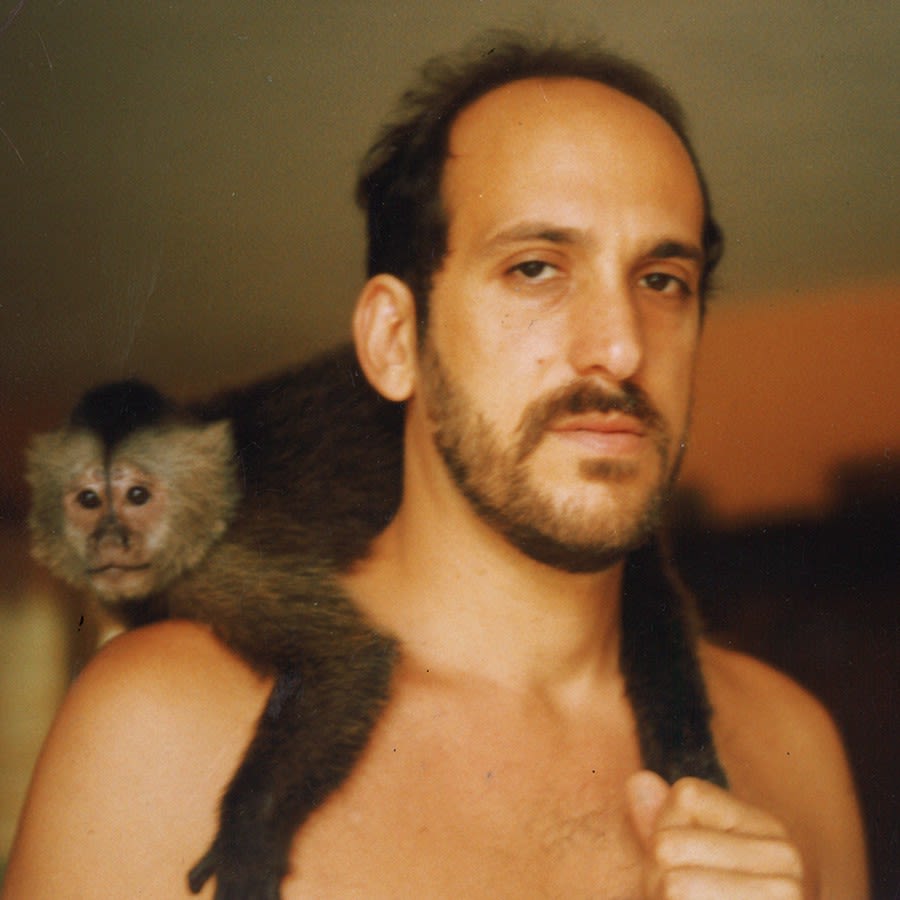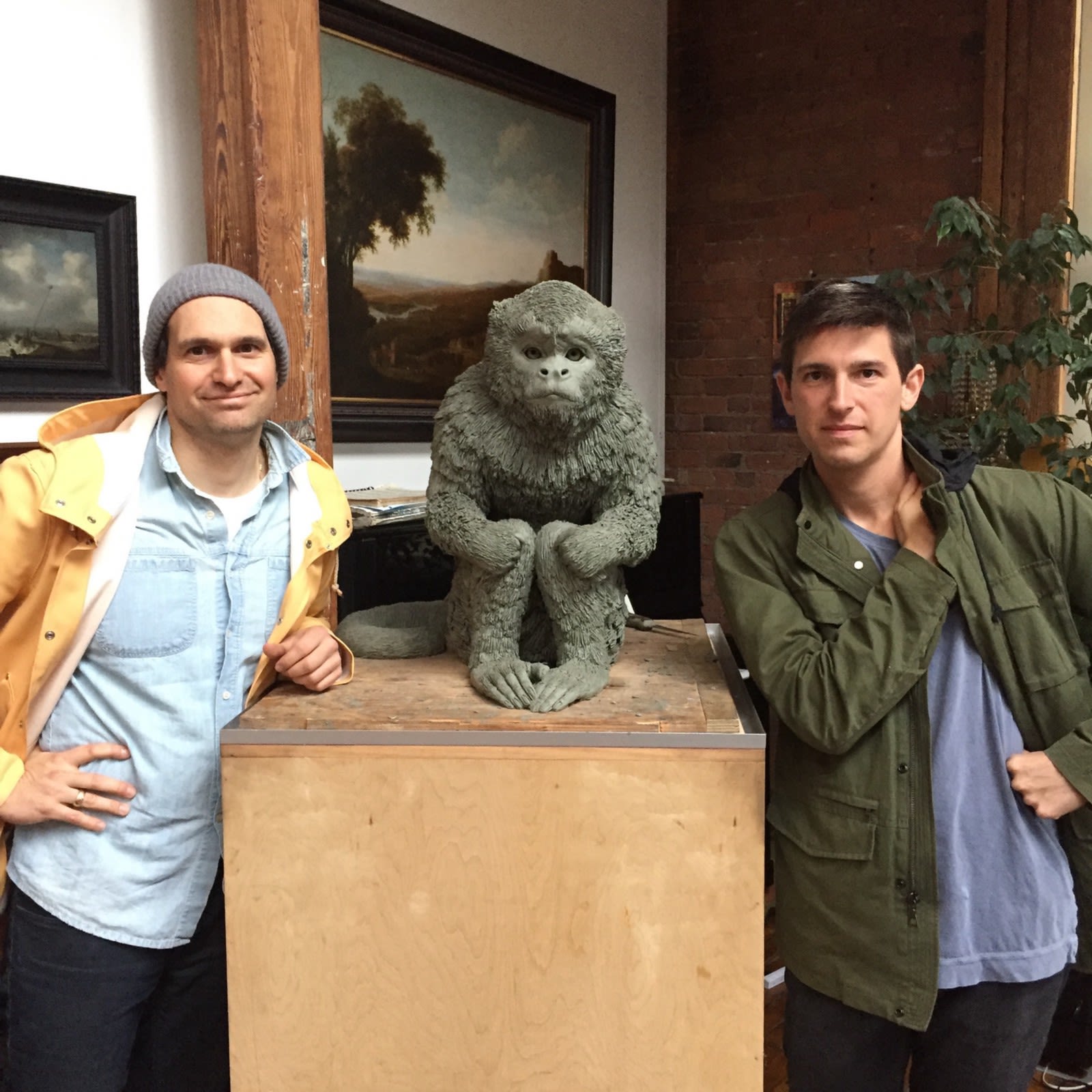Long Live Benjamin centers on the unusual relationship between Allen Hirsch, an accomplished artist, and Benjamin, an orphaned capuchin monkey. Hirsch and his wife, Belkis, discovered the monkey, abandoned and near death, while visiting Venezuela in 1997. Hirsch nursed the creature back to life, and then took the extraordinary step of bringing (well, smuggling) him into the U.S., where he took up residence in the couple’s New York apartment. There is much else about the story that is extraordinary (Monkey mayhem in a hotel lobby! A daring escape from Mexico, abetted by a game trucker! A monkey on the lam from the law! A monkey in the fridge!) so it’s a testament to Hirsch’s self-possessed demeanor, and to the directors’ light hand that Long Live Benjamin ends up being thought-provoking and poignant, not campy.
The filmmakers paint a unique portrait of an artist through the lens of an interspecies friendship, and in the process explore the porous boundaries between human and animal and what it means to be either (both?) of those things. That’s a lot of heavy lifting for a monkey. But Benjamin wasn’t just an exotic animal companion (Hirsch hated the term “pet.”) For Hirsch, Benjamin provided new eyes, a proxy consciousness, which changed him as a person and an artist. As he said in the NYT story around the film, Benjamin reminds us of our shared lineage. “We were connected at the heart: I brought out the human in him, and he brought out the monkey in me.”
The film begins after Benjamin’s death from cancer in 2011, when Hirsch channeled his grief and new artistic vision into a sculpture of his departed friend (at that point we also learn that he’s been keeping the monkey’s body in his freezer). And that’s when the filmmaking journey began for Lasser, who attended Benjamin’s burial and felt compelled to start filming Allen’s story. Over the course of nearly 10 years at W+K, Lasser has worked as an art director and creative director on some of the agency’s most well-known work for Chrysler (“Born of Fire,” “Halftime in America,”), Levi’s, Jordan, and Southern Comfort. His work has often touched on peculiarly American stories and characters, but this was his first real foray into long-form documentary filmmaking. Butler, an editor at Rock, Paper, Scissors had been working on a Chrysler spot with Lasser and ended up helping the creative director transfer early footage he’d shot. After surreptitiously viewing and assembling Lasser’s material, he became involved in the project, first as an editor and then as a directing partner. The two worked on the film over five years, with Alison Ables providing music. Butler’s colleagues at Rock Paper Scissors brought the project to The New York Times.
Here, Lasser talks about learning filmmaking on the fly and finding the dignity in the nearly unbelievable story of Long Live Benjamin.
What is this film about to you? Why did you want to tell this story?
I look at it as a portrait of an artist. An animal has a heightened sensitivity. Benjamin made Allen’s art better because it gave him a heightened sensitivity to light, to who he was painting, to the scenes he was painting, and I think that was really born out when he made a sculpture. I’ve known Allen a long time; he’s a painter, not a sculptor. When I saw him making that piece.. I thought it was very intriguing that he was passing along something through his hands and it was coming out of him in this new way.
When I was filming, that was the big picture, that’s what fascinated me the most. But, of course, it had a great, kind of preposterous story on top of it. Sort of like a Curious George story come to life in the city. There was that part that was fun.
There is so much to the story that is absurd, or unbelievable. But the film ends up being more moving than comical. How did you walk the line between absurd and earnest?
It would have been easy to make this a kooky man/dead monkey story. The mission was to give his story dignity. To do that I had to be more of a passive observer and let the viewer make the judgment.
The beauty of Allen is he makes a lot of sense. So the film is almost like a long argument to convince you of his side of the story. You start by seeing a man with a dead monkey and he’s sculpting him and you think he’s a nutjob. But by the end of it you think, “Oh that could happen to me.” And then maybe you turn the question on yourself. Do I have anything like this? What’s my Benjamin?
Given Allen is your cousin, how close were you to this story as it unfolded from 1997 on?
I was aware of Benjamin, of course. I held him when he was little but as he got older, he did get more aggressive and really kind of scary.
I was away when he died. The film started when I was living in Portland and I came to New York for a Chrysler shoot and stopped by to see Allen and pay my respects, and he said, “I’ve got him here in the fridge.” I saw that whole scene and I was instantly compelled to start recording. If all of that didn’t line up together I might not have made the film. I knew most of the story — it was family lore — but I needed that scene.
You’ve been telling stories as a creative director for a long time. How did that translate to directing a doc? Were you thinking of any of the filmmaking lessons of the people you worked with?
In a lot of ways the process was more like film school. It took a while because I think the story, and how to tell this complicated story, evolved. I wasn’t that prepared. I was like “this is incredible,” and then just started shooting and asking questions. I certainly got better at asking the right questions. I had to figure it out as I went along.
What advertising did help with was taking the longer film and turning it into episodes, per the Times’ request. We’re good at distilling a thing and finding its essence. And putting it in bite-sized segments. I can see how you’d want the enclosed space of a single film. I think without that, you lose the impact of the music and how deeply it immerses you in Allen’s story. In the episode format, I wonder if you get as emotionally invested in how he is feeling. But now, the way to get the most people to share a story is probably in episodic form. That’s just how people consume things.
The process of turning it into episodes sharpened the narrative of the long form. We went back and went through it all with an eye for finding the mini peaks and valleys in the narrative. His story had these points in it where it was like: here, a sane person would do one thing and then Allen would do the other thing. A sane person would be like, OK, just leave him in Venezuela and go home. Allen was like, no he has to go back to New York. He had a lot of those points which turned it into chapters nicely.
(ed note: neither Hirsch nor anyone here endorses the idea of importing or otherwise harboring a wild animal. It’s a terrible idea, and ends in suffering for all parties.)


